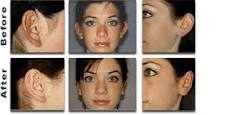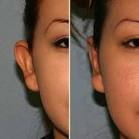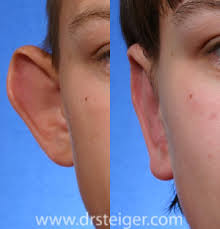Otoplasty Or Ear Surgery,Ear Pinning
Otoplasty, is a cosmetic surgery to change the appearance of a person's external ears. Otoplasty can take many forms, such as bringing the ears closer to the head (often called ear pinning), reducing the size of very big ears, or reshaping various bends in the cartilage. Other reconstructive procedures deal with the deformed, or absent (microtic) ears. Otoplasty surgery can involve a combination of moving, reshaping, adding, or removing structural ear elements. This procedure is usually performed by either an oral and maxillofacial surgeon, plastic surgeon, or ENT surgeon.
The pinna, or external ear, is made of a thin structural cartilage covered over with thin skin. Each of the various folds and structures of the pinna is named. Ear deformity results from distorted, damaged, or missing ear elements. Many otoplasties are performed not because of actual deformity, but because the individual is displeased with the shape of their ears.
Candidates for Otoplasty
Most cosmetic ear surgery patients are children between the ages of four and fourteen. The ears are fully grown by age four, and the sooner a child undergoes otoplasty, the less teasing and embarrassment he or she will experience growing up. Learn more about pediatric otoplasty.
Ear plastic surgery is also an excellent option for adults who suffer from large, protruding ears or stretched earlobes. Adults of all ages are generally excellent candidates for otoplasty surgery.
Although ear plastic surgery is known to be one of the safest plastic surgery procedures, there is always some risk involved in the procedure. Infection, overcorrection, and an extremely rare risk of altered hearing are all potential complications associated with ear surgery.
Side effects of otoplasty include postoperative pain, itching, and some degree of numbness. However, these are typically minimal and can usually be alleviated with medication.
Infection is one of the most common complications of any surgery. Infections can be easily combatted with antibiotics, however in rare cases infection can require surgical damage and could leave scar tissue.
Blood clots rarely occur, however when they do, they can easily be removed with a needle, or tthey may even dissolve naturally. If you experience any prolonged swelling and/or bleeding you should contact your surgeon to ensure that your ears are healing properly and there are no blood clots. Hearing loss is extremely rare and a highly skilled ear surgeon is able to evaluate the possibility of such a risk and take the necessary steps to avoid any hearing damage.




















The pinna, or external ear, is made of a thin structural cartilage covered over with thin skin. Each of the various folds and structures of the pinna is named. Ear deformity results from distorted, damaged, or missing ear elements. Many otoplasties are performed not because of actual deformity, but because the individual is displeased with the shape of their ears.
Candidates for Otoplasty
Most cosmetic ear surgery patients are children between the ages of four and fourteen. The ears are fully grown by age four, and the sooner a child undergoes otoplasty, the less teasing and embarrassment he or she will experience growing up. Learn more about pediatric otoplasty.Ear plastic surgery is also an excellent option for adults who suffer from large, protruding ears or stretched earlobes. Adults of all ages are generally excellent candidates for otoplasty surgery.
Ear Surgery (Otoplasty) Cost and Financing
The cost of ear surgery varies depending on the difficulty of patient's condition, extent of the surgery, experience of the surgeon, and other factors. Otoplasty typically costs around $2,000 to $5,000. Financing options for ear surgery are available.Preparing for Otoplasty
The otoplasty process begins with a consultation with a cosmetic surgeon. The surgeon will go over your ear surgery options and discuss your goals. Detailed pre-operative information and requirements will also be discussed. Otoplasty generally requires some form of sedation, and this will also be explained to you during a pre-operative appointment. Learn more about preparing for otoplasty.About the Ear Plastic Surgery Procedure
There are different types of surgery for ear correction, and depending on which one is being performed, otoplasty typically takes about one to two hours to complete. The patient is placed under sedation while the cartilage of the ear is reshaped and any excess skin removed. Read more about the otoplasty procedure.econstructive Ear Surgery (Otoplasty)
Ears affected by a birth deformity or a traumatic injury can be corrected with reconstructive ear surgery. Problems such as microtia (underdeveloped outer ear) and ear injuries can be treated with a variety of ear reconstruction procedures.Recovery from Ear Surgery
Postoperative ear surgery patients experience very few side effects. Recovery from ear surgery can take up to six weeks; however, adult patients can typically resume their normal routines a few days after their procedure. Children generally require a week of rest before going back to school.Otoplasty Results
Otoplasty involves one of the shortest recovery times of any plastic surgery procedure. Once the bandages are removed after the surgery, ear surgery results will be immediately visible. It is imperative that patients closely follow their surgeon's instructions and not tamper with or remove postoperative bandages before the surgeon allows.Otoplasty Risks, Benefits, and Side Effects
Cosmetic ear surgery can correct a variety of problems, including cupped, folded, or protruding ears. The procedure can also help eliminate self-esteem problems caused by having visible ear deformities. Learn more about the benefits of otoplasty.Although ear plastic surgery is known to be one of the safest plastic surgery procedures, there is always some risk involved in the procedure. Infection, overcorrection, and an extremely rare risk of altered hearing are all potential complications associated with ear surgery.
Side effects of otoplasty include postoperative pain, itching, and some degree of numbness. However, these are typically minimal and can usually be alleviated with medication.
Ear Surgery for Men
Ear plastic surgery has become one of the most popular cosmetic surgery procedures among men, being able to dramatically improve the appearance of the ears and provide a boost in self-confidence. Read more about male ear surgery.Are you suitable?
Surprisingly, ear surgery is best performed on children as the cartilage in their ears is more soft and pliable meaning that it is easier to be reshaped. The best results can be achieved on a child between the ages of 4 and 14. This doesn't mean that adults are ruled out though; cosmetic ear sugery is also an excelent option for adults who suffer from large or protuding ears or stretched earlobes.
People who are suitable for cosmetic ear surgery usually have one or more of the following concerns...
People who are suitable for cosmetic ear surgery usually have one or more of the following concerns...
- Large or protruding ears
- Enlarged earlobes
- ’Cauliflower ears’
- ’Lop ears’ (where the ear tips fold down and jut forward)
- Deformed or misshapen ears
- Very small ears
Before Surgery
The surgeon will examine your ears in a consultation and discuss with you the type of surgery which is best suited to your situation. In your consultation you should make clear to your surgeon your goals and expectations of the procedure.
A good surgeon will take you through the associated risks and complications of the surgery. It is important that before surgery, you are fully aware of the procedure, what is involved and the positive and negative implications of the surgery. Try and do some of your own research before your consultation so you can ask your surgeon well informed questions. This will enable you to make a more informed decision whether or not to go ahead.
It is a good idea to ask your surgeon to show you before and after pictures of previous clients so you can get an idea of the work they have done before and what can realistically be achieved.
Once you have decided to go ahead with the surgery, your surgeon will give you a consent form to sign; make sure you read this and all the associated material very carefully before you sign anything. The surgeon will also take photographs of your ears before surgery in order to make comparisons afterwards.
It is a good idea to make your Doctor aware of the surgery in case there are any complications afterwards and you need to go and see them.
A good surgeon will take you through the associated risks and complications of the surgery. It is important that before surgery, you are fully aware of the procedure, what is involved and the positive and negative implications of the surgery. Try and do some of your own research before your consultation so you can ask your surgeon well informed questions. This will enable you to make a more informed decision whether or not to go ahead.
It is a good idea to ask your surgeon to show you before and after pictures of previous clients so you can get an idea of the work they have done before and what can realistically be achieved.
Once you have decided to go ahead with the surgery, your surgeon will give you a consent form to sign; make sure you read this and all the associated material very carefully before you sign anything. The surgeon will also take photographs of your ears before surgery in order to make comparisons afterwards.
It is a good idea to make your Doctor aware of the surgery in case there are any complications afterwards and you need to go and see them.
Blood clots rarely occur, however when they do, they can easily be removed with a needle, or tthey may even dissolve naturally. If you experience any prolonged swelling and/or bleeding you should contact your surgeon to ensure that your ears are healing properly and there are no blood clots. Hearing loss is extremely rare and a highly skilled ear surgeon is able to evaluate the possibility of such a risk and take the necessary steps to avoid any hearing damage.






0 comments:
Post a Comment